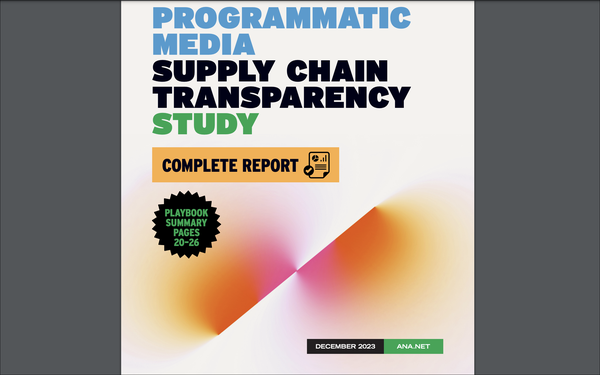Commentary
You've Read The ANA's Programmatic Report; Now What?
- by Richard Whitman , Columnist, December 5, 2023

The ANA’s Programmatic Media Transparency Supply Chain report, released today, is a lot to digest. The 125-page report has dozens of recommendations and questions to ask prior to making transactions, well worth considering given the estimated $22 billion in potential efficiency gains, per the report.
“The overarching headline from this report will no doubt be that of the $88 billion in open web spending, around 25% is wasteful or unproductive,” says Pranay Damji, programmatic & ad-tech consultant at ID Comms.
advertisement
advertisement
The report might seem a bit overwhelming, given all the recommendations, but Damji notes that not every suggested action needs to be implemented immediately and not every tip and other pieces of advice are applicable to every advertiser.
For example, says Damji, “implementing an inclusion list is fairly quick and easy, however accessing log-level data from every ad tech vendor across an advertiser’s supply chain is a much more complex, costly, and time-consuming task.”
And while recommendations to tackle information asymmetry and improve inventory quality and sustainability are “likely to apply to every advertiser, establishing a direct SSP contract may not be relevant until an advertiser reaches $50–$100 million in annual spending.”
“The real challenge for advertisers is not what to do--the report provides plenty of guidance in that regard--the challenge is to know where to start.”
And where is that exactly?
"Brands need to assess current programmatic operations across both the advertiser and the agency,” says Damji. By doing that first, he adds, “they will be able to understand the most applicable and impactful actions for their current state. Relevant actions can then be ranked in terms of implementation complexity with a roadmap developed to enable the execution of each in a systematic manner and a plan to implement more complex improvements at a suitable time.”
Many brands will need outside guidance to conduct that initial assessment and then interpret how to best implement suggestions from the report. But by doing so, Damji says, they will be able to take greater control of their programmatic investments, “leading to increased knowledge, savings, efficiency, transparency and sustainability."


